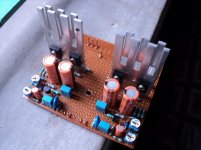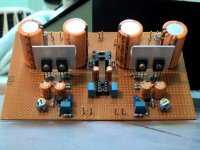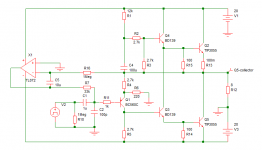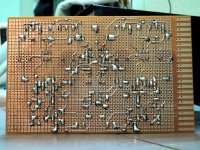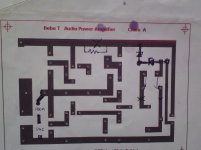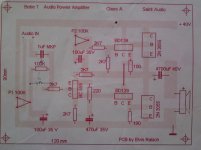DOZ - Death Of Zen 15 Watt Power Amplifier
Hi all.
The existing threads on DOZ seem to be about complains targeted to people who are not related to this amplifier and/or hollow debates on the supiriority of one amp over another.
So here is a thread where we can concentrate solely on DOZ as a standalone amplifier which produces music comparable to the sound of the best DIY Class-A amplifiers available.
I built both Capacitor coupled and Direct coupled versions; both with their advantages and disadvantages. The cap coupled version has less demand on the PS filtering and is less complex, while the direct coupled version has more stable bias and subjectively cleaner sound with no capacitor in the output and the feedback path.
Cheers...
PS. No Flaming Please, Comment only if you are interested in DOZ in a positive way.
Hi all.
The existing threads on DOZ seem to be about complains targeted to people who are not related to this amplifier and/or hollow debates on the supiriority of one amp over another.
So here is a thread where we can concentrate solely on DOZ as a standalone amplifier which produces music comparable to the sound of the best DIY Class-A amplifiers available.
I built both Capacitor coupled and Direct coupled versions; both with their advantages and disadvantages. The cap coupled version has less demand on the PS filtering and is less complex, while the direct coupled version has more stable bias and subjectively cleaner sound with no capacitor in the output and the feedback path.
Cheers...
PS. No Flaming Please, Comment only if you are interested in DOZ in a positive way.
Attachments
Last edited:
Hi Shaan
Nice work! Dare we ask for a peek at the underside (or should I say dare you show it? 😛)
A couple oh questions - What is the empty chip socket for in the 2'nd pic, and why on earth is there a tapped hole in one of the fins of the heatsink on the left?
btw, I found the DoZ details here on Rod Elliott's site, but no mention of a direct coupled version. Could you provide a schematic or a link?
Thanks - Godfrey
Nice work! Dare we ask for a peek at the underside (or should I say dare you show it? 😛)
A couple oh questions - What is the empty chip socket for in the 2'nd pic, and why on earth is there a tapped hole in one of the fins of the heatsink on the left?
btw, I found the DoZ details here on Rod Elliott's site, but no mention of a direct coupled version. Could you provide a schematic or a link?
Thanks - Godfrey
Hi Shaan
Nice work! Dare we ask for a peek at the underside (or should I say dare you show it? 😛)
Sure, tomorrow I will. Thanks.
A couple oh questions - What is the empty chip socket for in the 2'nd pic, and why on earth is there a tapped hole in one of the fins of the heatsink on the left?
The chip socket is for TL072, the offset servo. The tapped hole was there when I snatched the heatsinks from an ATX SMPS. 😀
btw, I found the DoZ details here on Rod Elliott's site, but no mention of a direct coupled version. Could you provide a schematic or a link?
Thanks - Godfrey
Sure, see the attachment.
Attachments
Last edited:
HI Shaan
What is the estimated output into 8 R with the balance circuit above ?
What is the difference in sound between this amp and JLH ?
Always admire you work .
thanks
kp93300
What is the estimated output into 8 R with the balance circuit above ?
What is the difference in sound between this amp and JLH ?
Always admire you work .
thanks
kp93300
kp93300,
The circuit is not balanced. The left board is capacitor coupled single supply type and the right board is direct coupled dual supply type with offset servo, both stereo. The above schematic shows the direct coupled design.
I don't know what the power output of a blanced circuit will be, but I am sure it will have less overall distortion.
The circuit is not balanced. The left board is capacitor coupled single supply type and the right board is direct coupled dual supply type with offset servo, both stereo. The above schematic shows the direct coupled design.
I don't know what the power output of a blanced circuit will be, but I am sure it will have less overall distortion.
Last edited:
Knowing Shaan, it will be just as neat as the topside 🙂 Very nice as usual Shaan!
Tony.
Thanks tony.
Hi Shaan
Nice work! Dare we ask for a peek at the underside (or should I say dare you show it? 😛)
Here it is.
Attachments
For the interested.
This is the exact schematic I used in the direct coupled version, everything except the power transistors are on-board. The diode-bridge+zener+bjt regulator for the opamp was a first time for me and it works well with no bad effect on the turn on/turn off event; i.e. no thump/click/pop etc..
This is the exact schematic I used in the direct coupled version, everything except the power transistors are on-board. The diode-bridge+zener+bjt regulator for the opamp was a first time for me and it works well with no bad effect on the turn on/turn off event; i.e. no thump/click/pop etc..
Attachments
What is the difference in sound between this amp and JLH ?
Always admire you work .
thanks
kp93300
Into 8ohm load, I found no difference between them when TIP3055 is used with DOZ and 2SC5200 used with JLH'69. When I revert the transistors an interesting thing happens. DOZ sounds too bright with 5200(HF oscillation?) and JLH sounds okay with 3055, although with less treble. JLH seems more forgiving to transistor varieties.
Still, I chose DOZ as my favorite as, when used with cheap 3MHz transistors, 1) it has perfect balance in bass, vocal, treble; I can listen all day without getting bored and 2) My 4ohm speakers sounds equally fantastic to 8ohm ones with DOZ, JLH didn't pass this test.

Thanks for the kind words.
Gain of this circuit
Hi Shaan
What is the gain of this circuit ?
How do i adjust the gain ?
thanks
kp93300
Hi Shaan
What is the gain of this circuit ?
How do i adjust the gain ?
thanks
kp93300
This is the exact schematic I used in the direct coupled version, everything except the power transistors are on-board. The diode-bridge+zener+bjt regulator for the opamp was a first time for me and it works well with no bad effect on the turn on/turn off event; i.e. no thump/click/pop etc..
Here it is.
Lovely piece of work.
The best £35 I ever spent was on a Laser Printer so that I could do Toner Transfer PCBs.
Hi Shaan
How to adjust VR1 and VR2? What to measure during adjustment?
Can i parallel the TIP 3055 for more power?
What is the maximum Vin ?
Sorry for so many questions?
You have build so many amps and by your recommendation, I think I will give it a try also.
I am extremely happy with a JLH 69 using 2n 3055 and if this can beat it, i will be over the moon !
thanks
kp93300
How to adjust VR1 and VR2? What to measure during adjustment?
Can i parallel the TIP 3055 for more power?
What is the maximum Vin ?
Sorry for so many questions?
You have build so many amps and by your recommendation, I think I will give it a try also.
I am extremely happy with a JLH 69 using 2n 3055 and if this can beat it, i will be over the moon !
thanks
kp93300
Hi Shaan
What is the gain of this circuit ?
How do i adjust the gain ?
thanks
kp93300
The default gain is 13. You can increase this by decreasing the value of the 220ohm resistor near the PNP input transistor. However, this design has low open loop gain to start with, so keeping the closed loop gain less than 15 is a good idea for low overall distortion. After all this is a low power amplifier.
Mr Shaan
excellent job like always
regards Nikos
Thanks nikos.
Lovely piece of work.
Thank you.
Hi Shaan
How to adjust VR1 and VR2? What to measure during adjustment?
Start with maximum resistance, then slowly increase bias to about 1.7Amp. I do it by connecting a 1ohm/5watt resistor in series with one of the supplies and measuring the voltage around it. In the servo controlled circuit only the bias current needs to be monitored as the output offset is nulled by the servo In the capacitor coupled version the offset varies(although by small amount) with varying Iq.
Can i parallel the TIP 3055 for more power?
Yes, but you will need low impedance(say 4ohm) speakers or paralleled higher impedance speakers to get the extra watts.

What is the maximum Vin ?
~1.5Volts for maximum power
Sorry for so many questions?
You have build so many amps and by your recommendation, I think I will give it a try also.
All the best from me.

I am extremely happy with a JLH 69 using 2n 3055 and if this can beat it, i will be over the moon !
thanks
kp93300
Let's see! 😀 I believe you are soon to be over the moon...
.
I agree totally with Mr Robertson, it indeed has that "JLH" full rounded class-a sound, plus better bass and low impedance load management. Nice simple PCB layout there.
That is amazing work Shaan, it must have taken a very long time to complete!! What do you use to hold the conductors in place while soldering, and how do you bend them like that??
Into 8ohm load, I found no difference between them when TIP3055 is used with DOZ and 2SC5200 used with JLH'69. When I revert the transistors an interesting thing happens. DOZ sounds too bright with 5200(HF oscillation?) and JLH sounds okay with 3055, although with less treble. JLH seems more forgiving to transistor varieties.
Hi all. I am getting the parts together for a DOZ and I was going to use 2SC5200 which I bought specifically for this circuit. Would you recommend I use the 2N3055H instead as I have some of these anyway?
Thanks 😉
That is amazing work Shaan, it must have taken a very long time to complete!!
Thank you.
Planning/placing/soldering the parts and pins - 1 hour. Soldering the connector - 2 hours.
What do you use to hold the conductors in place while soldering, and how do you bend them like that??
With a Tweezer.
The conductors are just cut-off legs of the resistors and capacitors, 100 parts=200 conductors, so I don't have to buy wires for this task. I hold the conductor with the tweezer, dip one end in the flux, tin the end with the iron, solder it to a joint on the board, press the conductor towards the board and make it flat over the board, bend it with the tweezer to reach the joint to be interconnected, solder the other end, and the cycle repeats.
Hi all. I am getting the parts together for a DOZ and I was going to use 2SC5200 which I bought specifically for this circuit. Would you recommend I use the 2N3055H instead as I have some of these anyway?
Thanks 😉
I noticed the DOZ to sound best with slow to medium fast transistors. So I will recommend anything with upto 3MHz fT. 2N3055 is just fine for DOZ. Read the article on ESP site for more information on this.
With the 5200s I noticed the treble to sound disturbingly bright. Also these damn-fast transistors need some kind of oscillation prevention mechanism to be installed, like a Zobel or a capacitor in parallel with the series feedback resistor or a dominant pole capacitor(bandlimiting- bad, bad idea). Even an unearthed heatsink may cause oscillation when superfast transistors are used. As prevention is better than cure, so I use TIP3055s and the author of this design says that DOZ works(sounds) just as fine with 3055s, I found it to be true. As this is a current feedback circuit making the transistors work close to their maximum speed, the transient response is usually excellent even with slow transistors like 2N3055s. I have some 2N5296 TO220 devices with 800KHz fT and tested them with DOZ; they sound the same, awesome.
Last edited:
- Home
- Amplifiers
- Solid State
- Death of Zen 15 watt Power Amplifier
